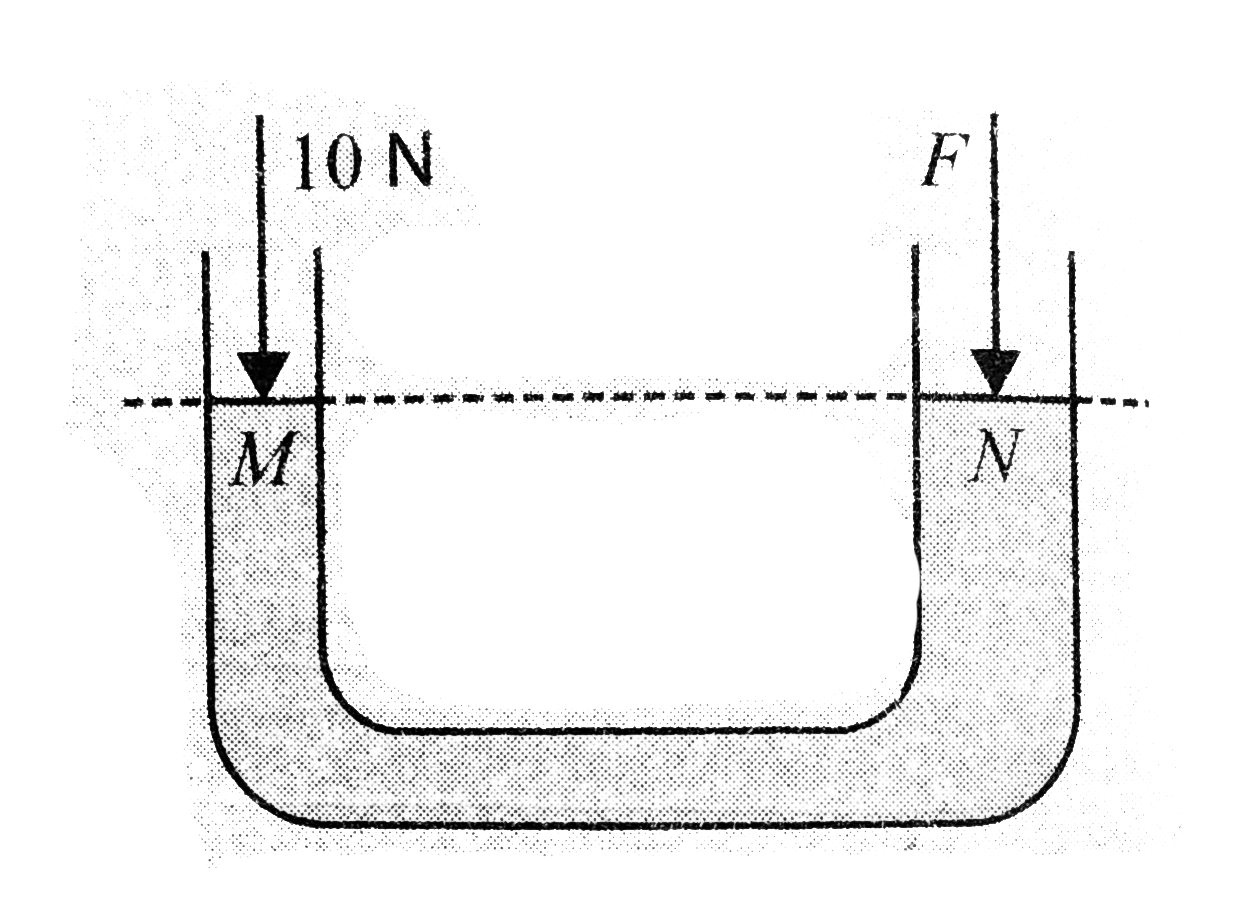The cross-section of two piston in hydraulic press are 2cm2and150cm2 respectivley . Calculate the minimum force required to support a weight of 2000kg wt on the broader face of the press.
The correct Answer is:(261.3N)
To solve the problem, we need to use the principle of hydraulic systems, which states that the pressure applied to a confined fluid is transmitted undiminished throughout the fluid.
1. Identify the Given Values:
- Cross-sectional area of the smaller piston, A1=2cm2
- Cross-sectional area of the larger piston, A2=150cm2
- Weight supported on the larger piston, W=2000kg
2. Convert the Weight to Force:
- The force due to the weight can be calculated using the formula:
Fweight=W⋅g
- Where g (acceleration due to gravity) is approximately 9.81m/s2.
- Thus,
Fweight=2000kg⋅9.81m/s2=19620N
3. Calculate the Pressure on the Larger Piston:
- Pressure is defined as force per unit area:
P2=FweightA2
- Convert A2 from cm² to m²:
A2=150cm2=150×10−4m2=0.015m2
- Now calculate the pressure:
P2=19620N0.015m2=1308000Pa
4. Set Up the Pressure Equation for the Smaller Piston:
- Since the pressure is the same on both sides, we can write:
P1=P2
- Therefore,
F1A1=P2
5. Calculate the Minimum Force Required on the Smaller Piston:
- Rearranging the equation gives:
F1=P2⋅A1
- Convert A1 from cm² to m²:
A1=2cm2=2×10−4m2=0.0002m2
- Now substitute the values:
F1=1308000Pa⋅0.0002m2=261.6N
6. Final Answer:
- The minimum force required to support the weight of 2000 kg on the broader face of the press is approximately:
F1≈261.6N
- Cross-sectional area of the smaller piston, A1=2cm2
- Cross-sectional area of the larger piston, A2=150cm2
- Weight supported on the larger piston, W=2000kg
- The force due to the weight can be calculated using the formula:
Fweight=W⋅g
- Where g (acceleration due to gravity) is approximately 9.81m/s2.
- Thus,
Fweight=2000kg⋅9.81m/s2=19620N
- Pressure is defined as force per unit area:
P2=FweightA2
- Convert A2 from cm² to m²:
A2=150cm2=150×10−4m2=0.015m2
- Now calculate the pressure:
P2=19620N0.015m2=1308000Pa
- Since the pressure is the same on both sides, we can write:
P1=P2
- Therefore,
F1A1=P2
- Rearranging the equation gives:
F1=P2⋅A1
- Convert A1 from cm² to m²:
A1=2cm2=2×10−4m2=0.0002m2
- Now substitute the values:
F1=1308000Pa⋅0.0002m2=261.6N
- The minimum force required to support the weight of 2000 kg on the broader face of the press is approximately:
F1≈261.6N
Topper's Solved these Questions
Similar Questions
The area of cross section of two cylinders of a Bramah press are 10cm2and50cm2, respectively. In order to move up a weight of 100 placed on the bigger piston. what force should be applied on the smaller piston of smaller area ?
View SolutionAn object of weight 500kgwt is lifted by using a hydraulic press. The radii of the cross sections of the pump piston and press piston are 10 cm and 20 cm, respectively. Calculate the effort required to lift the object. Calculate the displacement of the load if the effort is moved through a distance of 20 cm.
View Solution
Knowledge Check
- Question 1 - Select One
The area of cross-section of the two vertical arms of a hydraulic press are 1 cm2 and 10cm2 respectively. A force of 10N applied. As shown in the figure, to a tight fitting light piston in the thinner arm balances a force F applied to the corresponding piston in the thicker arm. Assuming that the levels of water in both the arms are the same, we can conclude:-
 AF=100NBF=50NCF=25NDF, as applied, cannot balance the effect of the force on the first piston
AF=100NBF=50NCF=25NDF, as applied, cannot balance the effect of the force on the first piston - Question 2 - Select One
A pipe of non uniform cross section has two distinct section 1 and 2 with areas 2cm2 and 4cm2 respectively. If the velocity of flowing liquid at section 1 is 5cm/s, determine the velocity at section 2.
Av2=5cm/sBv2=2cm/sCv2=25cm/sDv2=2.5cm/s
An object of weight 500kgwt is lifted by using a hydraulic press. The radii of the cross sections of the pump piston and press piston are 10 cm and 20 cm, respectively. Calculate the effort required to lift the object. Calculate the displacement of the load if the effort is moved through a distance of 20 cm.
View SolutionThe area of cross section of the two arms of a hydraulilc press are 1 cm^2 and 10 cm^2 respectively figure. A force of 5N is applied on the water in the thinner arm. What force should be applied on the water in the thicker arm so that the water may remain in equilibrium?
 ,View Solution
,View SolutionThe area of cross section of the two arms of a hydraulic press is 1cm2 and 20cm2 respectively. A force of 10N is applied on the water in the thinner arm. What force should be applied on the water in the thicker arms so that water may remain in equilibrium?
 View Solution
View SolutionIn a hydraulic press, the area of smaller and larger pistons are 5cm2and20cm2, respectively. Calculate the weight which can be raised by larger piston if a force of 100 kgf is applied on smaller piston.
View SolutionThe diameters of smaller and larger pistons in a hydraulic press are 3 cm and 15 cm respectively. To move out the larger piston by 0.4 cm calculate the distance through which the smaller piston should be pushed in.
View SolutionTwo pistons of hydraulic press have diameter of 30.0cm and 2.5cm, find the force exerted on the longer piston when 50.0kg wt. is placed on smaller piston.
View Solution

